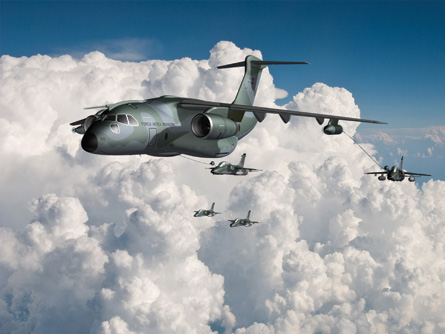Embraer's roots are in defence. Its first aircraft - the EMB 110 Bandeirante - was built for the Brazilian armed forces in the early 1970s, and it designed the AMX fighter with Italian industry in the 1980s. Embraer also developed the Tucano and Super Tucano light fighters. However, as the firm focused on commercial and business aviation in the 1990s and 2000s, defence took a back seat.
The launch of the KC-390 in 2008 changed that. Although maintenance work, special mission and other modifications and Super Tucano sales have kept the defence division ticking over, the military transport is Embraer's biggest and arguably most ambitious aircraft to date, and will help to elevate the defence segment to an expected 25% of Embraer's revenues by 2020.
With the Brazilian government helping to underwrite the programme with an order for 28 of the IAE V2500-powered twinjet, Embraer has secured further commitments (though not firm orders) for 32 aircraft from Argentina, Chile, Colombia, the Czech Republic and Portugal. All five countries are expecting industrial participation, with Czech firm Aero Vodochody and Portugal's EEA and Embraer subsidiary OGMA among those already lined up as programme partners.
The prototype of the KC-390 is due to fly by the end of 2014, with a targeted service entry with the Brazilian air force of 2016. Luiz Carlos Aguiar, the president of Embraer's defence business, sees a potential market for the 23-tonne payload airlifter of around 100 aircraft - mostly replacements for older versions of the ubiquitous Lockheed Martin C-130 Hercules - assuming a 15% market share for Embraer. "There are a lot of ageing C-130s out there," he says.
AMBITIONS
 |
|---|
Embraer Five countries, plus Brazil, have commited to KC-390 |
But Embraer's defence ambitions do not stop with the KC-390. Aguiar is keen to follow companies such as Lockheed Martin, Finmeccanica and BAE Systems and position Embraer in the growing homeland security segment - with a World Cup and Olympics coming up in Brazil, as well as pressing needs to control borders and deter drugs trafficking, this could prove a lucrative market. But it will require developing technologies within Brazil, and this will mean Embraer partnering with or even making "middle-size acquisitions" of the companies behind the technology, he says.
Linking with international companies in this sphere is not an option, however. "They have developed their own technology and consolidated their markets. It doesn't make sense for them to open up to us," says Aguiar. "Our model is to take our capability, take it through Brazilian acquisitions and then export a Brazilian solution." Ideas being developed for the domestic market today, he says, "could in five years be exported to Africa and Latin America. There are lots of countries growing fast from a small base, and like Brazil will face future changes in social demands."
Another departure for the business is unmanned air systems. Late last year Embraer formed a venture with Israel's Elbit, Harpia Systemas, to develop tactical and strategic UAS for the air force for border protection. An Elbit Hermes 450 will provide the initial platform. However, Aguiar says Brazil, rather than Israel, will own much of the intellectual property. "We have technology here in Brazil. The air force needs to have commonality with datalinks, so it is not going to buy off the shelf from Israel. It has to be very specific for a Brazilian environment."
RESURGENCE
An established product - the Super Tucano - is also is enjoying a resurgence, in a security role. Embraer was dealt a blow in February when a contract to supply 20 of the trainer aircraft for a US Light Aircraft Support requirement for surveillance in Afghanistan , with US partner Sierra Nevada, was put on hold after a challenge by rival Hawker Beechcraft. However, while the USA remains very much in Embraer's sights for the Super Tucano, counter-insurgency demands in Asia and Africa have helped to deliver strong sales, with Angola, Burkina Faso and Mauritania among recent customers. "We estimate that the counter-insurgency market represents around 300 aircraft to 2020," says Aguiar. "And we conservatively expect to sell 50% of these."
Source: Flight International
















